Location-Based Tracking Data and Customer Movement Pattern Analysis for Sustainable Fashion Business
Abstract
1. Introduction
2. Background and Literature Review
2.1. Visual Merchandising and Customer Movement Patterns
2.2. Mobile Tracking Data—Indoor Positioning System
2.2.1. Triangulation
2.2.2. Radio Fingerprinting
3. Research Design
3.1. Experimental Settings
3.1.1. Objective
3.1.2. Store Setting
3.2. Location-Based Tracking Technology
3.3. Methodology
3.3.1. Data Transformation
3.3.2. Process Mining
4. Experimental Results
4.1. Overview
4.2. Study 1—Changing VMD on the First Floor
4.2.1. VMD Rearrangement Decision
4.2.2. Purchase Funnel
4.2.3. Bounce Rate
4.2.4. Share of Movements
4.2.5. Stay Rate
4.2.6. Sales
4.3. Study 2—Changing VMD on the Second Floor
4.3.1. VMD Rearrangement Decision
4.3.2. Share of Movements
4.3.3. Length of Stay
4.4. Study 3—Cross Displaying
4.4.1. Cross-Displaying Decision
4.4.2. Sales
4.4.3. Sales Breakdowns
5. Conclusions
Author Contributions
Funding
Conflicts of Interest
References
- Kerfoot, S.; Davies, B.; Ward, P. Visual merchandising and the creation of discernible retail brands. Int. J. Retail Distrib. Manag. 2003, 31, 143–152. [Google Scholar] [CrossRef]
- Mehta, N.; Chugan, P.K. The impact of visual merchandising on impulse buying behavior of consumer: A case from Central Mall of Ahmedabad India. Univers. J. Manag. 2013, 1, 76–82. [Google Scholar]
- Park, H.H.; Jeon, J.O.; Sullivan, P. How does visual merchandising in fashion retail stores affect consumers’ brand attitude and purchase intention? IJRDM 2015, 25, 87–104. [Google Scholar] [CrossRef]
- Hwangbo, H.; Kim, Y.S.; Cha, K.J. Use of the Smart Store for Persuasive Marketing and Immersive Customer Experiences: A Case Study of Korean Apparel Enterprise. Mob. Inf. Syst. 2017, 2017, 1–17. [Google Scholar] [CrossRef]
- Bleisch, S.; Duckham, M.; Galton, A.; Laube, P.; Lyon, J. Mining candidate causal relationships in movement patterns. IGISFR 2014, 28, 363–382. [Google Scholar] [CrossRef][Green Version]
- Hwangbo, H.; Kim, J.; Lee, Z.; Kim, S. Store layout optimization using indoor positioning system. Int. J. Distrib. Sensor Netw. 2017, 13, 1550147717692585. [Google Scholar] [CrossRef]
- Kuntz, M.; Helbich, M. Geostatistical mapping of real estate prices: An empirical comparison of kriging and cokriging. Int. J. Geogr. Inf. Sci. 2014, 28, 1904–1921. [Google Scholar] [CrossRef]
- Syaekhoni, M.A.; Alfian, G.; Kwon, Y.S. Customer purchasing behavior analysis as alternatives for supporting in-store green marketing decision-making. Sustainability 2017, 9, 2008. [Google Scholar] [CrossRef]
- Waechter, S.; Sütterlin, B.; Borghoff, J.; Siegrist, M. Letters, signs, and colors: How the display of energy-efficiency information influences consumer assessments of products. Energ. Res. Soc. Sci. 2016, 15, 86–95. [Google Scholar] [CrossRef]
- De Gregorio, F.; Sung, Y. Understanding attitudes toward and behaviors in response to product placement. J. Advert. 2010, 39, 83–96. [Google Scholar] [CrossRef]
- Williams, K.; Petrosky, A.; Hernandez, E.; Page, R., Jr. Product placement effectiveness: revisited and renewed. JMMR 2011, 7, 1. [Google Scholar]
- Wu, J.; Won Ju, H.; Kim, J.; Damminga, C.; Kim, H.-Y.; KP Johnson, K. Fashion product display: An experiment with Mockshop investigating colour, visual texture, and style coordination. Int. J. Retail Distrib. Manag. 2013, 41, 765–789. [Google Scholar] [CrossRef]
- Zhu, M.; Dong, J.; Gao, Y. The Research on Temporal–Spatial Distribution and Morphological Characteristics of Ancient Settlements in the Songhua River Basin. Sustainability 2019, 11, 932. [Google Scholar] [CrossRef]
- Lux, M.; Anagnostopoulos, N.; Iakovidou, C. Spatial pyramids for boosting global features in content based image retrieval. In Proceedings of the 2016 14th International Workshop on Content-Based Multimedia Indexing (CBMI), Bucharest, Romania, 15–17 June 2016; 2016; pp. 1–4. [Google Scholar]
- Owusu, G.; Wrigley-Asante, C.; Oteng-Ababio, M.; Owusu, A.Y. Crime prevention through environmental design (CPTED) and built-environmental manifestations in Accra and Kumasi, Ghana. Crime Prev. Community Saf. 2015, 17, 249–269. [Google Scholar] [CrossRef]
- Law, D.; Wong, C.; Yip, J. How does visual merchandising affect consumer affective response? An intimate apparel experience. Eur. J. Mark. 2012, 46, 112–133. [Google Scholar] [CrossRef]
- Kawaf, F.; Tagg, S. Online shopping environments in fashion shopping: An SOR based review. Market Rev. 2012, 12, 161–180. [Google Scholar] [CrossRef]
- Jain, V.; Sharma, A.; Narwal, P. Impact of Visual Merchandising on Consumer Behavior towards Women’s Apparel. IJRM 2012, 5, 106–117. [Google Scholar]
- Swobodzinski, M.; Raubal, M. An indoor routing algorithm for the blind: development and comparison to a routing algorithm for the sighted. Int. J. Geogr. Inf. Sci. 2009, 23, 1315–1343. [Google Scholar] [CrossRef]
- Kveladze, I.; Kraak, M.-J.; Van Elzakker, C.P.J.M. The space-time cube as part of a GeoVisual analytics environment to support the understanding of movement data. Int. J. Geogr. Inf. Sci. 2015, 29, 2001–2016. [Google Scholar] [CrossRef]
- Sung, Y. RSSI-based distance estimation framework using a Kalman filter for sustainable indoor computing environments. Sustainability 2016, 8, 1136. [Google Scholar] [CrossRef]
- Kim, D. Performance of UWB Wireless Telecommunication Positioning for Disaster Relief Communication Environment Securing. Sustainability 2018, 10, 3857. [Google Scholar] [CrossRef]
- Tsai, H.-R.; Chen, T. Enhancing the sustainability of a location-aware service through optimization. Sustainability 2014, 6, 9441–9455. [Google Scholar] [CrossRef]
- Yu, H.; Lee, H.; Jeon, H. What is 5G? Emerging 5G Mobile Services and Network Requirements. Sustainability 2017, 9, 1848. [Google Scholar] [CrossRef]
- Curran, K.; Furey, E.; Lunney, T.; Santos, J.; Woods, D.; McCaughey, A. An evaluation of indoor location determination technologies. JLBS 2011, 5, 61–78. [Google Scholar] [CrossRef]
- Fallah, N.; Apostolopoulos, I.; Bekris, K.; Folmer, E. Indoor human navigation systems: A survey. Interact Comput. 2013, 25, 21–33. [Google Scholar]
- Liu, H.; Darabi, H.; Banerjee, P.; Liu, J. Survey of wireless indoor positioning techniques and systems. IEEE Trans. Syst. Man Cybern. Part C 2007, 37, 1067–1080. [Google Scholar] [CrossRef]
- Chiou, Y.-S.; Wang, C.-L.; Yeh, S.-C. An adaptive location estimator using tracking algorithms for indoor WLANs. Wirel. Netw. 2010, 16, 1987–2012. [Google Scholar] [CrossRef]
- Petrie, H.; Johnson, V.; Strothotte, T.; Raab, A.; Fritz, S.; Michel, R. MoBIC: Designing a travel aid for blind and elderly people. J. Navig. 1996, 49, 45–52. [Google Scholar] [CrossRef]
- Gu, Y.; Lo, A.; Niemegeers, I. A survey of indoor positioning systems for wireless personal networks. IEEE Commun. Surv. Tutor. 2009, 11, 13–32. [Google Scholar]
- He, S.; Chan, S.-H.G. Wi-Fi fingerprint-based indoor positioning: Recent advances and comparisons. IEEE Commun. Surv. Tutor. 2016, 18, 466–490. [Google Scholar] [CrossRef]
- Xiao, Z.; Wen, H.; Markham, A.; Trigoni, N.; Blunsom, P.; Frolik, J. Non-line-of-sight identification and mitigation using received signal strength. IEEE Trans. Wirel. Commun. 2015, 14, 1689–1702. [Google Scholar] [CrossRef]
- Li, Q.; Li, W.; Sun, W.; Li, J.; Liu, Z. Fingerprint and assistant nodes based Wi-Fi localization in complex indoor environment. IEEE Access 2016, 4, 2993–3004. [Google Scholar] [CrossRef]
- Kim, Y.; Lee, J.; Jeong, J.; Chong, S. Multi-flow rate control in delayed Wi-Fi offloading systems. In Proceedings of the 2016 International Conference on Information Networking (ICOIN), Kota Kinabalu, Malaysia, 13–15 January 2016; pp. 274–279. [Google Scholar]
- D. M. M. I. Center. Digital. Consumer and Korean Digital Lifestyle; Seoul, Korea, 2015; p. 12. Available online: http://www.dmcmedia.co.kr/notice/noticeView?dc_idx=22&dn_idx=393 (accessed on 5 March 2018).
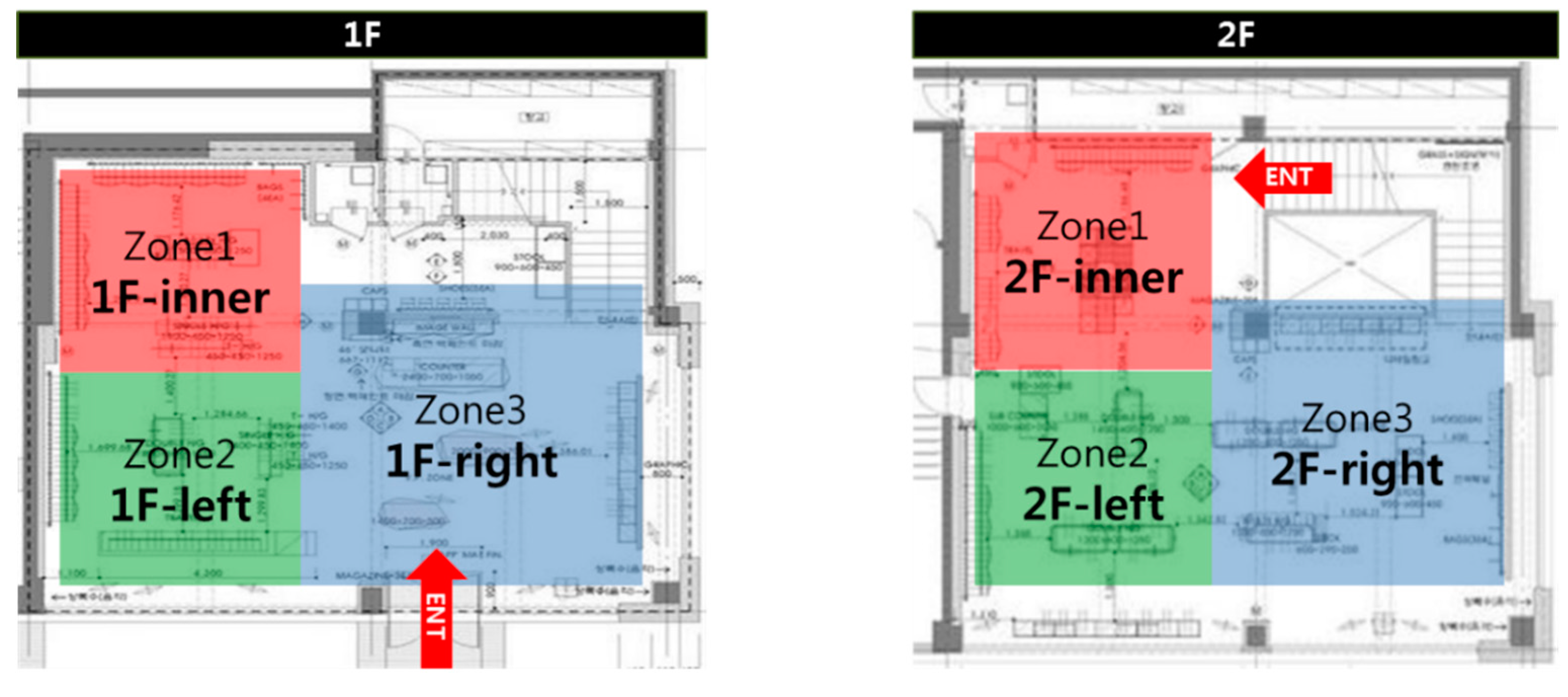
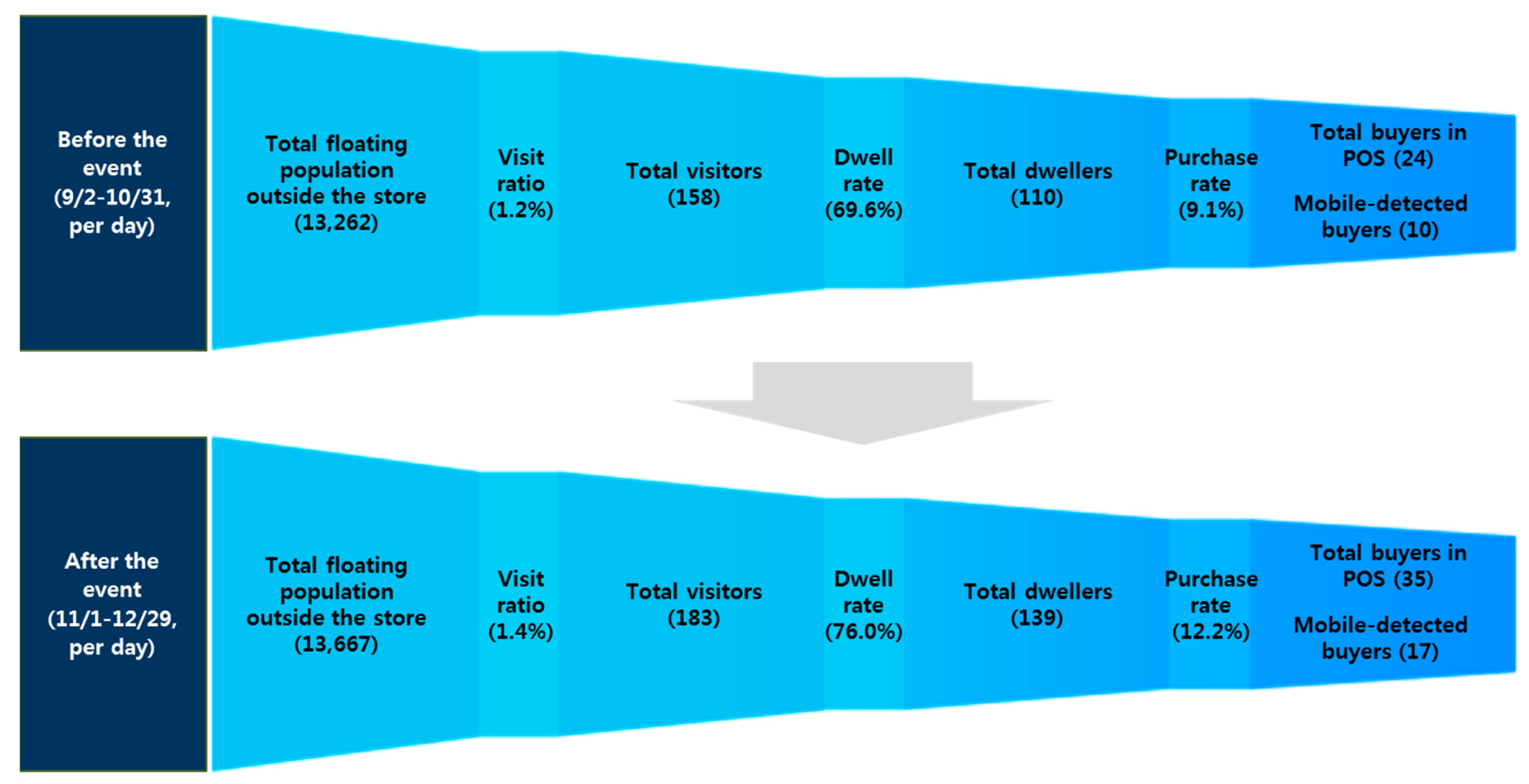
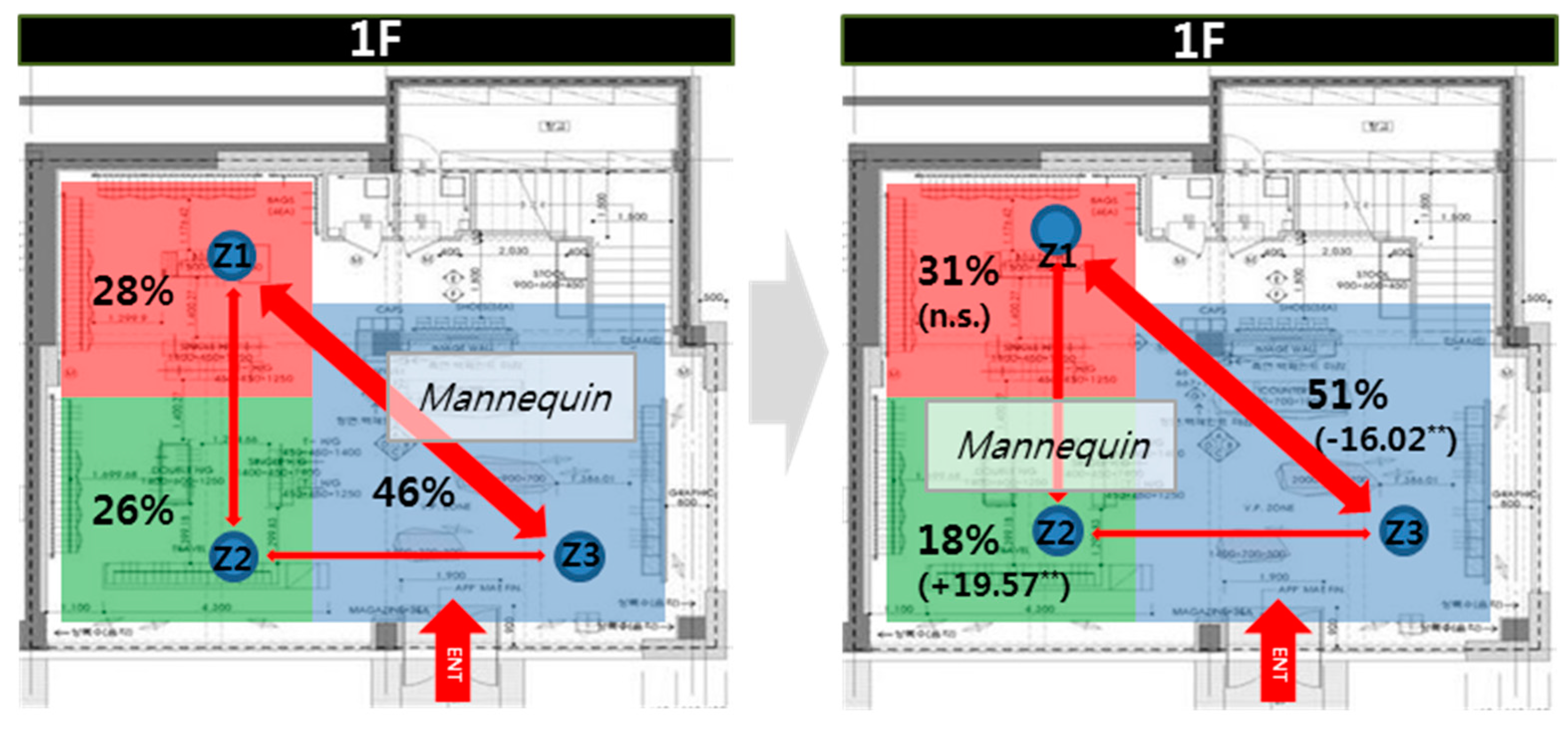
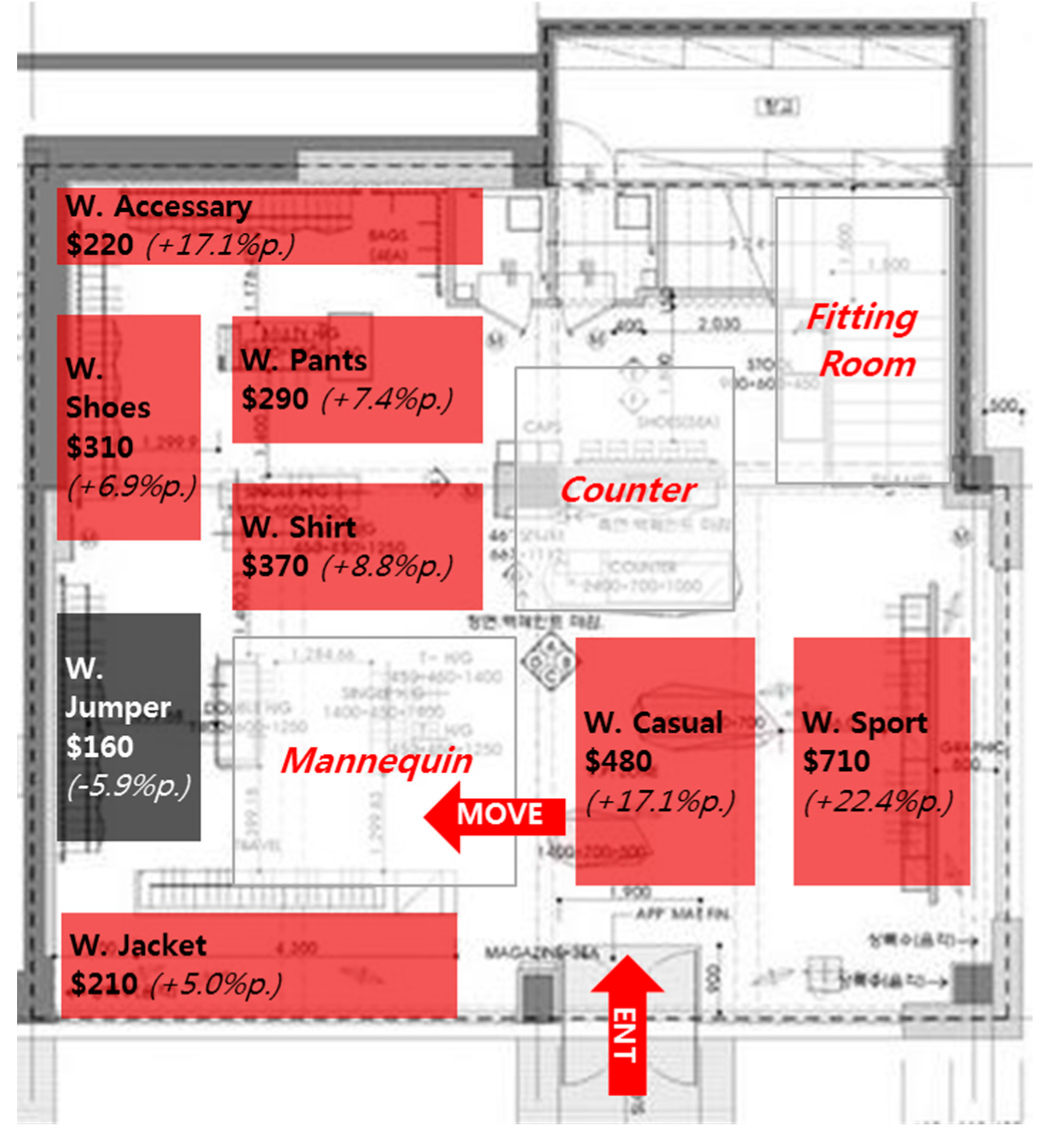
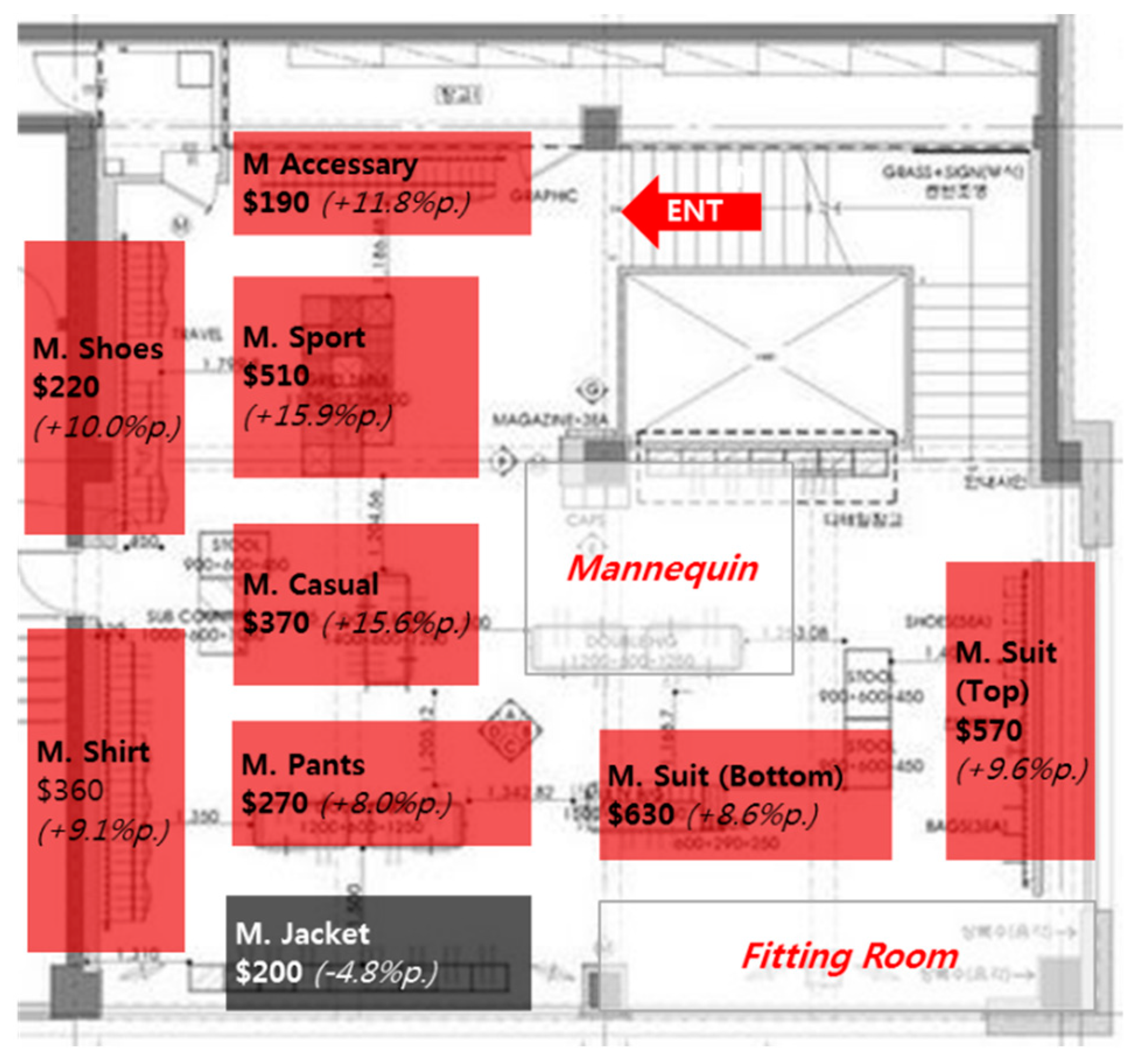
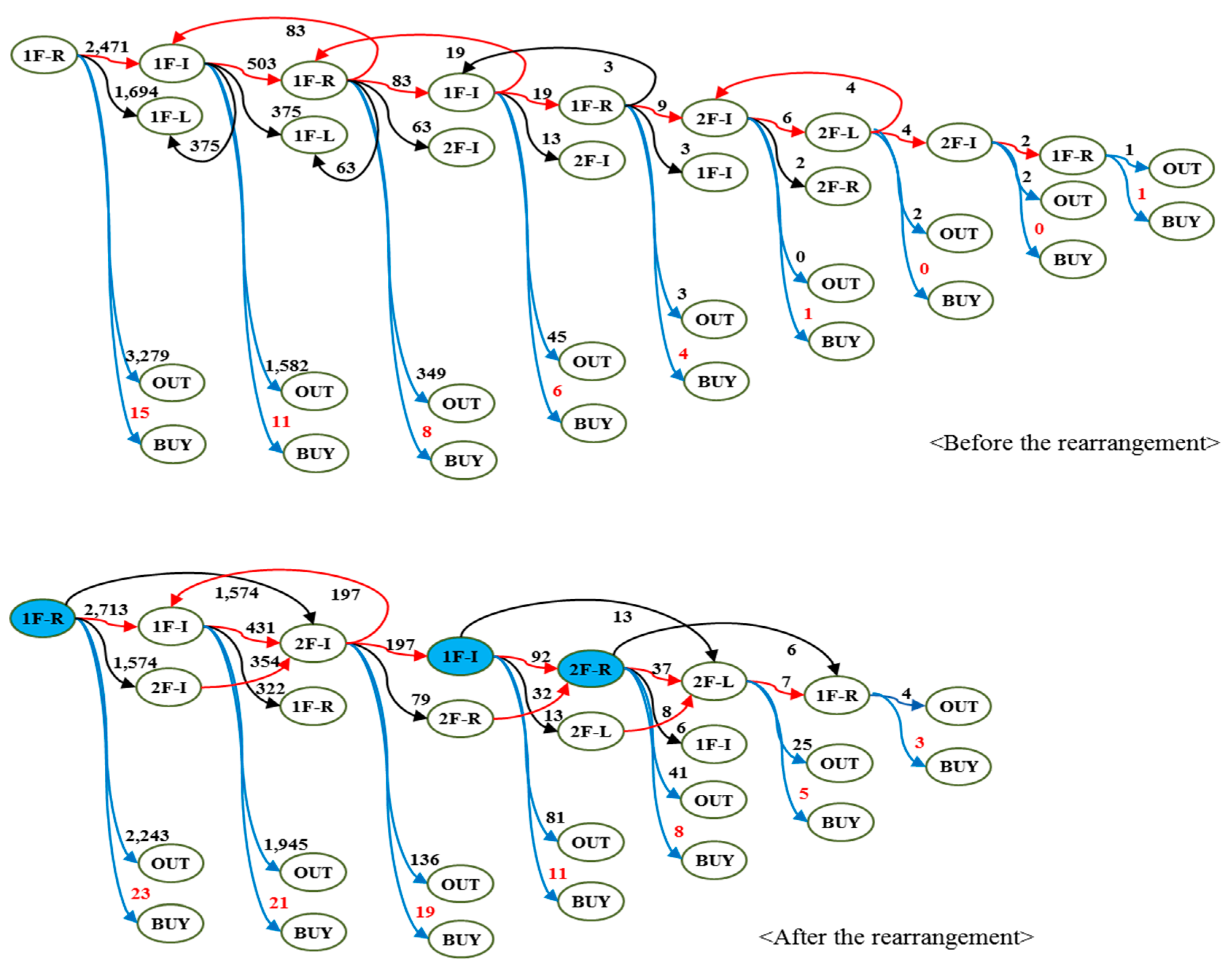
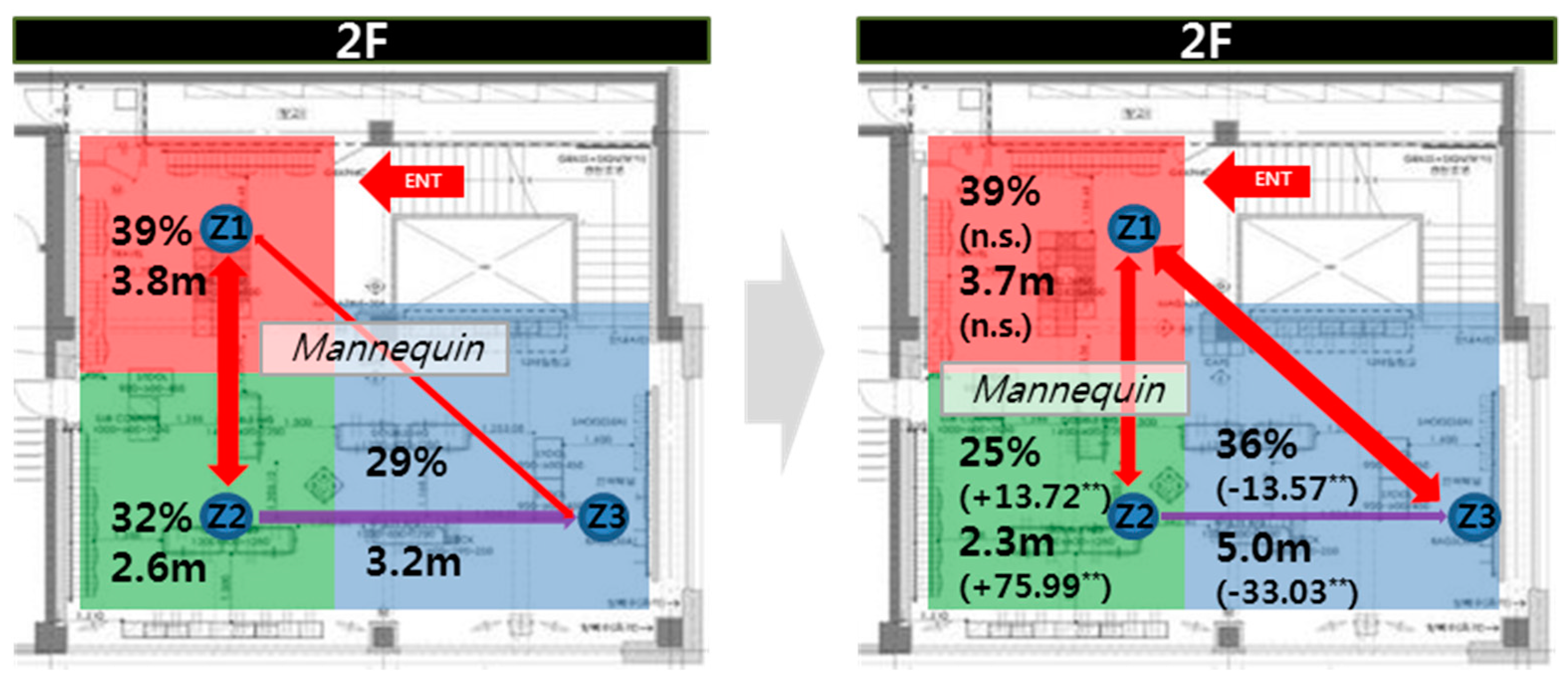
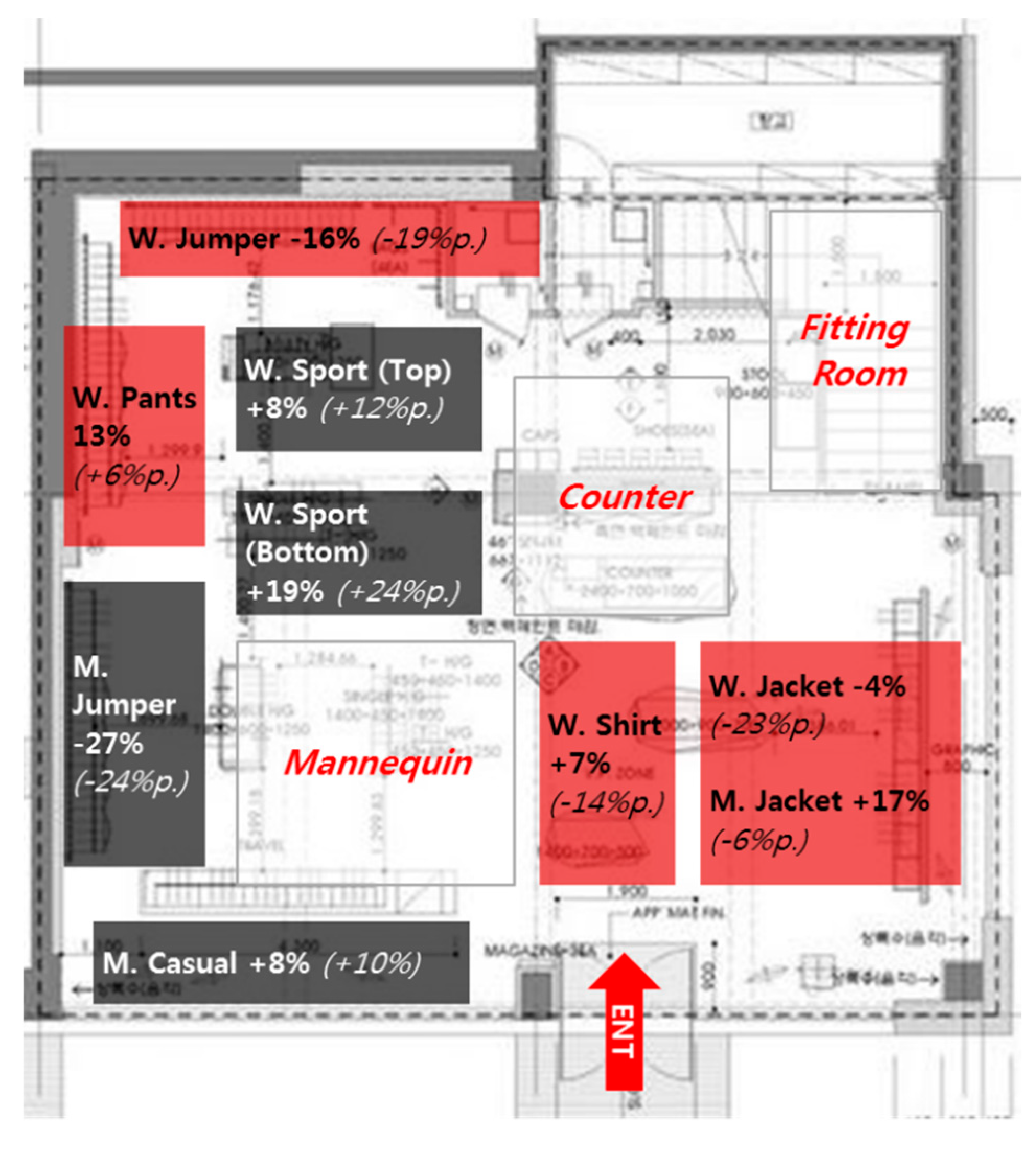
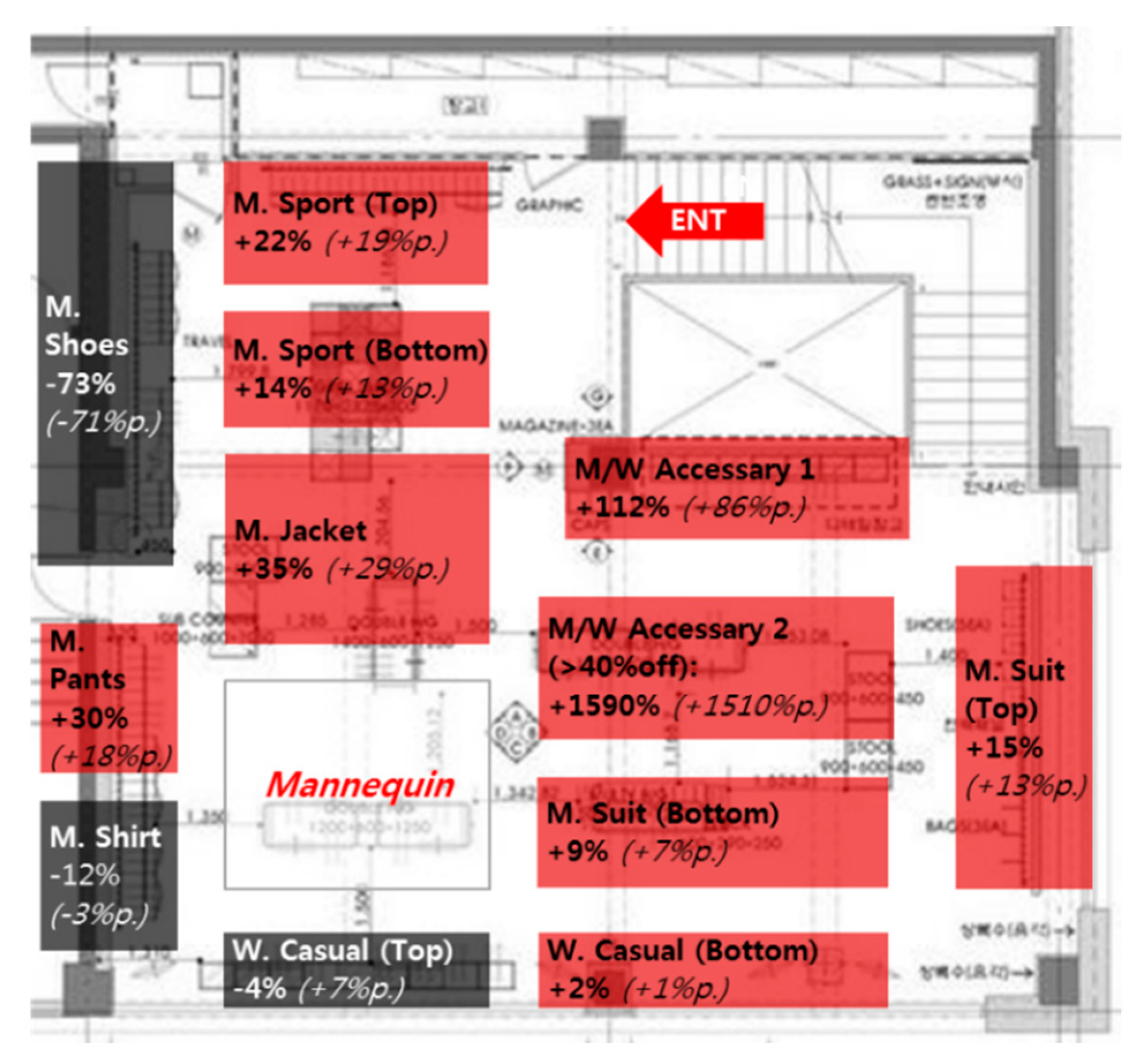
| Authors | Wireless Technology Used | Path-based Analysis | Customer Behavior Analysis | Case-based Study | Sales Data Used | Layout Optimization |
|---|---|---|---|---|---|---|
| Kerfoot, Davies, and Ward [1] | X | X | O | O | X | X |
| Law et al. [16] | X | X | O | O | X | X |
| Kawaf and Tagg [17] | X | X | O | O | X | X |
| Jain et al. [18] | X | X | O | O | X | X |
| Park, Jeon, and Sullivan [3] | X | X | O | O | X | X |
| Kuntz and Helbich [7] | O | O | X | O | X | X |
| Swobodzinski and Raubal [19] | X | O | X | O | X | X |
| Waechter, Sütterlin, Borghoff, and Siegrist [9] | O | O | O | O | X | O |
| De Gregorio and Sung [10] | X | O | O | O | O | X |
| Williams, Petrosky, Hernandez, and Page Jr [11] | X | O | O | O | O | X |
| Wu, Won Ju, Kim, Damminga, Kim, and KP Johnson [12] | O | O | X | O | O | O |
| Our Study | O | O | O | O | O | O |
| Zone | Group | N | Mean | Standard Deviation | Standard Error | t-Value | p-Value |
|---|---|---|---|---|---|---|---|
| 1F-inner | Round 1 | 60 | 0.2806 | 0.0996 | 0.0129 | −1.86 | n.s. |
| Round 2 | 60 | 0.3149 | 0.1023 | 0.0132 | |||
| 1F-left | Round 1 | 60 | 0.2531 | 0.0199 | 0.0028 | 19.57 | ** |
| Round 2 | 60 | 0.1810 | 0.0205 | 0.0026 | |||
| 1F-right | Round 1 | 60 | 0.4586 | 0.0149 | 0.0019 | −16.02 | ** |
| Round 2 | 60 | 0.5110 | 0.0205 | 0.0026 |
| Zone | Division | Group | N | Mean | Standard Deviation | Standard Error | t-Value | p-Value |
|---|---|---|---|---|---|---|---|---|
| 2F-inner | share | Round 1 | 60 | 0.3881 | 0.0199 | 0.0026 | -0.78 | n.s. |
| Round 2 | 60 | 0.3910 | 0.0205 | 0.0026 | ||||
| time | Round 1 | 60 | 3.7773 | 0.2685 | 0.0347 | 1.37 | n.s. | |
| Round 2 | 60 | 3.7176 | 0.2030 | 0.0262 | ||||
| 2F-left | share | Round 1 | 60 | 0.3178 | 0.0279 | 0.0036 | 13.72 | ** |
| Round 2 | 60 | 0.2465 | 0.0290 | 0.0038 | ||||
| time | Round 1 | 60 | 2.5981 | 0.0224 | 0.0029 | 75.99 | ** | |
| Round 2 | 60 | 2.3018 | 0.0203 | 0.0026 | ||||
| 2F-right | share | Round 1 | 60 | 0.2885 | 0.0341 | 0.0044 | −13.51 | ** |
| Round 2 | 60 | 0.3561 | 0.0184 | 0.0024 | ||||
| time | Round 1 | 60 | 3.2090 | 0.2974 | 0.0384 | −33.03 | ** | |
| Round 2 | 60 | 5.0381 | 0.3091 | 0.0399 |
| Bi-Directional Route (30) | Previous Period (Sep. to Oct.) | Post Period (Nov. to Dec.) | Changes (%) | t-Value (Sig.) | ||
|---|---|---|---|---|---|---|
| Sales ($) | % | Sales ($) | % | |||
| 1F-R→1F-L | 23,474 | 4.1 | 23,071 | 3.7 | −1.72 | 21.14 ** |
| 1F-R→1F-I | 23,582 | 4.1 | 28,812 | 4.6 | 22.18 | 17.89 ** |
| 1F-R→2F-I | 24,624 | 4.3 | 30,048 | 4.8 | 22.03 | −47.57 ** |
| 1F-R→2F-L | 23,027 | 4.0 | 29,329 | 4.7 | 27.37 | 60.34 ** |
| 1F-R→2F-R | 29,512 | 5.2 | 38,127 | 6.0 | 29.19 | 79.73 ** |
| 1F-L→1F-I | 11,824 | 2.1 | 11,011 | 1.7 | 6.88 | −19.22 ** |
| 1F-L→2F-I | 11,311 | 2.0 | 14,055 | 2.2 | 24.26 | 43.91 ** |
| 1F-L→2F-L | 9,893 | 1.7 | 12,714 | 2.0 | 28.52 | 81.25 ** |
| 1F-L→2F-R | 15,522 | 2.7 | 19,224 | 3.0 | 23.85 | 42.16 ** |
| 1F-I→2F-I | 9,544 | 1.7 | 11,252 | 1.8 | 17.90 | 32.94 ** |
| 1F-I→2F-L | 9,312 | 1.6 | 10,957 | 1.7 | 17.67 | −17.18 ** |
| 1F-I→2F-R | 15,014 | 2.6 | 17,122 | 2.7 | 14.04 | n.s. |
| 2F-I→2F-L | 13,045 | 2.3 | 12,722 | 2.0 | −2.48 | n.s. |
| 2F-I→2F-R | 32,075 | 5.6 | 40,188 | 6.4 | 25.29 | −17.41 ** |
| 2F-L→2F-R | 33,399 | 5.9 | 32,442 | 5.1 | −2.87 | n.s. |
| 1F-L→1F-R | 24,554 | 4.3 | 23,955 | 3.8 | −2.44 | 19.34 * |
| 1F-I→1F-R | 26,684 | 4.7 | 29,468 | 4.7 | 10.43 | −21.74 ** |
| 2F-I→1F-R | 23,354 | 4.1 | 25,715 | 4.1 | 10.11 | 16.75** |
| 2F-L→1F-R | 22,885 | 4.0 | 24,744 | 3.9 | 8.12 | n.s. |
| 2F-R→1F-R | 29,473 | 5.2 | 34,712 | 5.5 | 17.78 | 14.24 ** |
| 1F-I→1F-L | 21,541 | 3.8 | 21,011 | 3.3 | −2.46 | 19.85 ** |
| 2F-I→1F-L | 11,284 | 2.0 | 11,047 | 1.8 | −2.10 | n.s. |
| 2F-L→1F-L | 9,425 | 1.7 | 9,207 | 1.5 | −2.31 | n.s. |
| 2F-R→1F-L | 14,525 | 2.5 | 13,971 | 2.2 | −3.81 | −15.38 ** |
| 2F-I→1F-I | 11,297 | 2.0 | 11,852 | 1.9 | 4.91 | 13.29 ** |
| 2F-L→1F-I | 11,894 | 2.1 | 12,088 | 1.9 | 1.63 | n.s. |
| 2F-R→1F-I | 14,938 | 2.6 | 15,084 | 2.4 | 0.98 | n.s. |
| 2F-L→2F-I | 13,527 | 2.4 | 12,822 | 2.0 | −5.21 | 25.82 ** |
| 2F-R→2F-I | 23,087 | 4.1 | 28,724 | 4.6 | 24.42 | −13.79 ** |
| 2F-R→2F-L | 26,112 | 4.6 | 24,927 | 4.0 | −4.54 | n.s. |
| Total | 569,738 | 100.0 | 630,401 | 100.0 | 10.6 | 35.41 ** |
| ANOVA Table | ||||||||
|---|---|---|---|---|---|---|---|---|
| Source | DF | SS | MS | F-Value | p-Value | |||
| Model | 2 | 1228323.23 | 6141615.61 | 5315.33 | <0.0001 ** | |||
| Error | 180 | 207981.72 | 1155.45 | |||||
| Corrected Total | 182 | 12491212.95 | ||||||
| LSM Adj. for Multiple Comparisons: Tukey-Kramer | ||||||||
| Year_Type1 | Year_Type2 | Year_Type3 | ||||||
| Year_Type1 | - | 0.1020 | <0.0001 ** | |||||
| Year_Type2 | 0.1020 | - | <0.0001 ** | |||||
| Year_Type3 | <0.0001 ** | <0.0001** | - | |||||
© 2019 by the authors. Licensee MDPI, Basel, Switzerland. This article is an open access article distributed under the terms and conditions of the Creative Commons Attribution (CC BY) license (http://creativecommons.org/licenses/by/4.0/).
Share and Cite
Kim, J.; Hwangbo, H.; Kim, S.J.; Kim, S. Location-Based Tracking Data and Customer Movement Pattern Analysis for Sustainable Fashion Business. Sustainability 2019, 11, 6209. https://doi.org/10.3390/su11226209
Kim J, Hwangbo H, Kim SJ, Kim S. Location-Based Tracking Data and Customer Movement Pattern Analysis for Sustainable Fashion Business. Sustainability. 2019; 11(22):6209. https://doi.org/10.3390/su11226209
Chicago/Turabian StyleKim, Jonghyuk, Hyunwoo Hwangbo, Sung Jun Kim, and Soyean Kim. 2019. "Location-Based Tracking Data and Customer Movement Pattern Analysis for Sustainable Fashion Business" Sustainability 11, no. 22: 6209. https://doi.org/10.3390/su11226209
APA StyleKim, J., Hwangbo, H., Kim, S. J., & Kim, S. (2019). Location-Based Tracking Data and Customer Movement Pattern Analysis for Sustainable Fashion Business. Sustainability, 11(22), 6209. https://doi.org/10.3390/su11226209






